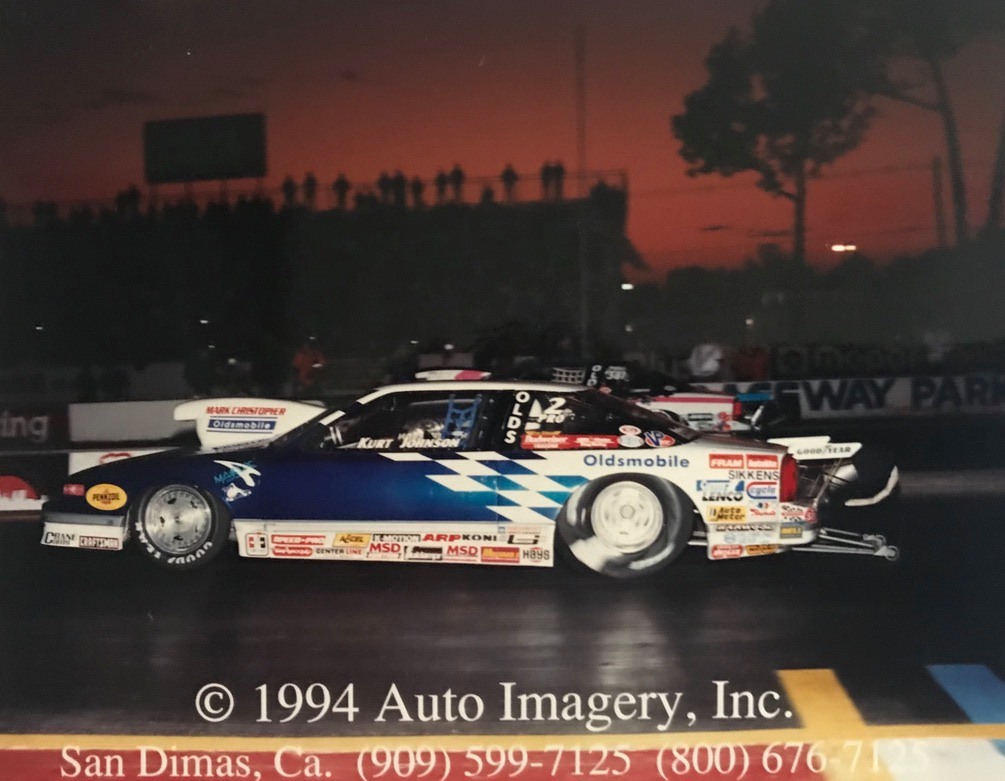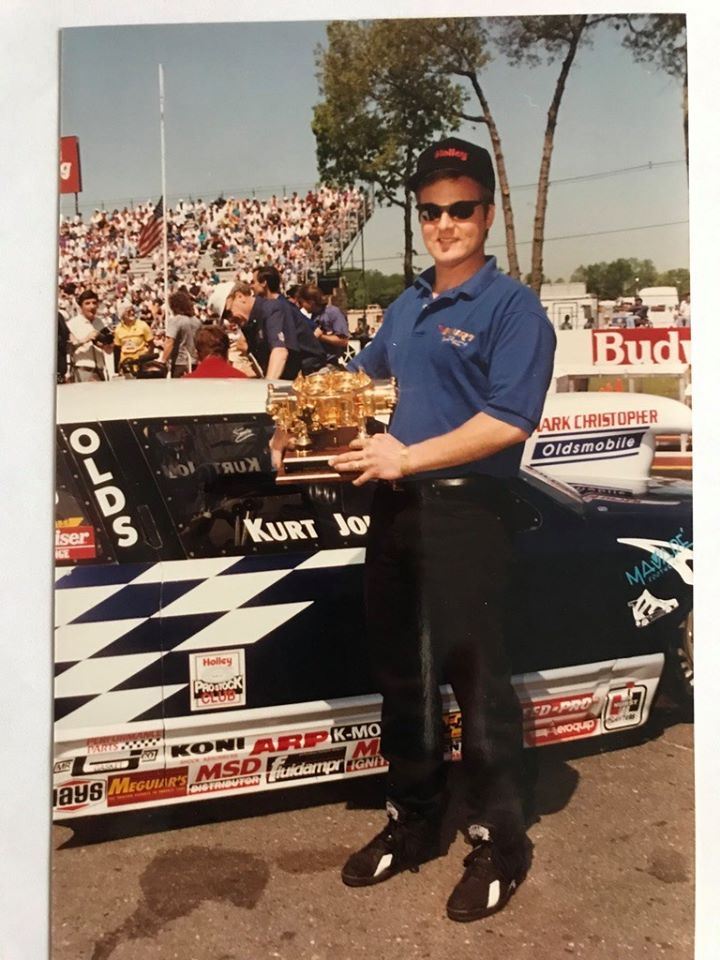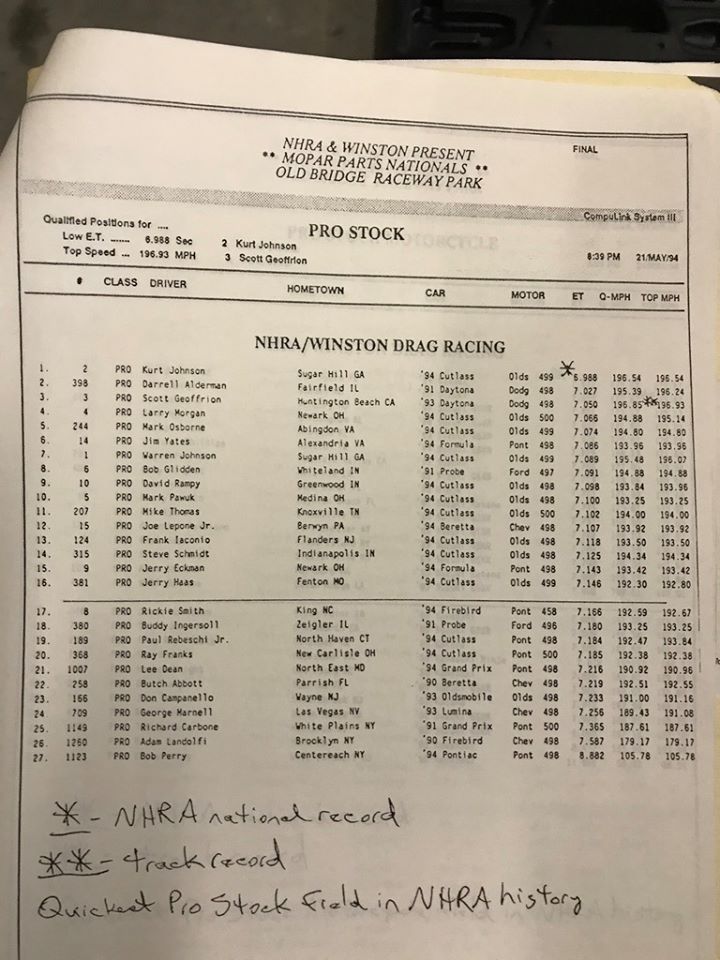THE DAY KURT JOHNSON SOLIDIFIED HIS PLACE IN DRAG RACING HISTORY

 There was no doubt that sometime, at some point, someone was going to be the first NHRA Pro Stock driver to break into the six-second zone on a quarter-mile pass.
There was no doubt that sometime, at some point, someone was going to be the first NHRA Pro Stock driver to break into the six-second zone on a quarter-mile pass.
The question was who would be the driver to secure that spot in drag racing history.
Good ol’ conventional wisdom thought it would come down to a pair of Dodge drivers, Darrell Alderman and Scott Geoffrion, or Warren Johnson, a.k.a., “The Professor,” in his Georgia-based Oldsmobile.
In near-perfect conditions on Friday night, May 20, 1994, Alderman, Geoffrion and Johnson took their shots and came up short by several hundredths.
Johnson’s son, Kurt, didn’t squander his opportunity, as a few minutes later he blistered the Raceway Park strip in Englishtown, N.J., in 6.998 seconds. Aside from his spot in the history books as the first six-second Pro Stocker, Kurt Johnson earned $25,000 for the feat.
“We tried to run six seconds every chance we could, but Mother Nature wouldn’t let us at certain tracks,” Kurt said Wednesday from the Warren Johnson Enterprises shop in Sugar Hill, Ga. “Ever since they put that gold (Holley) carburetor in front of us at Pomona” drivers had focused on being the first in the sixes.
“Me and (Bob) Glidden were standing there looking at it and were thinking, ‘Man, we ain’t got nothing that looks this nice. Ours are all ratty and dirty and used.’ ”
Tracks that could have produced a six earlier in the season didn’t have the right conditions on race weekend. As Warren Johnson recalled in an interview, the proper weather conditions were in place outside Houston, where the strip is listed by NHRA as being 10 feet above sea level, “but the track was bumpy.” Then, at Gainesville, Fla., the track was primed for a six, but the weather was “unseasonably warm” for mid-March.
That left the next-best candidate as Raceway Park, located about 25 miles inland from the Atlantic Ocean at approximately 70 feet above sea level.
As Kurt Johnson recalls, he expected someone to notch the first six at Englishtown because of the track itself in combination with the weather.
“We landed on Thursday night back in the day, it was like 38 degrees and cold and rainy and there was hail coming down,” he said. “But we were thinking, ‘Man, this is the place. If it’s going to happen, it’s going to happen here.’ ”
At the time, NHRA allowed teams to enter the staging lanes for qualifying runs at their leisure; a practice no longer permitted. Kurt Johnson delayed his arrival as long as possible for multiple reasons.
“You could be first, you could be last. People would wait and wait and wait,” said Johnson, who was one of 27 Pro Stock entrants for the Summernationals. “They’d be running motorcycles and there’d be one or two cars up there when there’d only be one or two pair of bikes left. …
“I just waited it out. I think I was the third pair from the back. Air conditions were getting better and better and better. And then when you run on your rubber -- Pro Stock rubber -- the track is much better.”
Both Johnsons had to abort their first-session qualifying passes due to tire shake. In the ensuing round, Warren had an electrical issue and could only muster a 7.08. Alderman got close, but not close enough, with a 7.02 shot.
Eventually, it was Kurt’s turn, and he made as beautiful a pass down the strip as any driver could want.
“The front end was in the air, it was going straight, and I was pulling gears faster than I ever pulled them,” he said. “The more gears I pulled, the faster I went. Man, what a run. … We got a good lick in.”
 Without a two-way radio to learn of his car’s performance, Johnson only realized he’d broken into the sixes when announcer Steve Evans and his video crew arrived on the scene.
Without a two-way radio to learn of his car’s performance, Johnson only realized he’d broken into the sixes when announcer Steve Evans and his video crew arrived on the scene.
“Englishtown was short,” Johnson said, “but we had really, really big parachutes on these cars at the time. I didn’t make it to the last turnoff where all the TV crew was. Steve Evans, they came up the return road, and when they parked at my car, I knew we had it.”
The historic blast was only the beginning of a huge weekend for Johnson. The next day, he earned $50,000 for capturing the Budweiser Pro Stock Challenge, and he reached the semifinals of eliminations on Sunday. All told, he earned more than $90,000 for his three days behind the wheel of his Olds Cutlass.
“That track was so iffy in the middle of the day, you go to shaking the tires,” he said. “But when that sun went off of it and it got cool and track temp went down, that place got mean. We just struggled in the middle of the day; one of those things.”
“The prestige, the money to do it first is something you never forget. That was quite a weekend.”
Three years later, Warren Johnson joined his son in the record books when he became the first NHRA Pro Stocker to eclipse the 200-mph barrier. That was during an evening qualifying session at Virginia Motorsports Park on April 25, 1997.
“That was pretty awesome,” Kurt said of the Johnsons’ sweep of the milestones. “Both motors came out of the same place, same operation. The nitrous Dodges didn’t get it, that’s what made me happy. The crowd loved it. That was a fun place to race right there, the crowd enthusiasm.”
Warren, Kurt said, “had changed the rear-end gear. ‘Alright, we’re going to put our speed gear in there. We might not run the ET, but it’s going to run some speed out the back.’ Danged if it didn’t,” at 200.13 mph.
Kurt Johnson’s blast into the sixes occurred very early in his career. He had made his competitive debut in Pro Stock less than 18 months earlier, and he won three times in seven final-round appearances as a rookie and was the points runner-up to his father. When Kurt’s career concluded in spring 2014, he had won 40 national events -- including the U.S. Nationals in 1996-97 -- and was a four-time runner-up for the championship.
Johnson raced his record-setting Don Ness-built car the rest of 1994 and all of ’95. It was sold when he and his dad switched to Pontiac Firebirds for ’96.
The 57-year-old still works with his father at the family business in Sugar Hill, Ga., pitching in with engine assembly and handling all the work on their dynamometer.
“If we had some money now, we’d be out there” racing, he said.
“At the end, the traveling just got old. The TSA and the big hassle, just … you were just running all the time, no matter what you did,” he said.
“This particular thing we do here, you learn something new every day,” he said. “You’re sort of doing the same thing, but you keep tweaking on how you do it. ‘I used to do it like this for a long time, why don’t I do it like that?’ You’re doing the same thing, you’re just doing it better, whether it’s quicker or more efficient or what have you.”
His occupation is anything but a sedentary job. On a typical day in the shop, he said, his FitBit will show him having logged 22,000 steps.
“So imagine,” he said, “how many I was doing when we were wide open!”






































